版权所有:内蒙古大学图书馆 技术提供:维普资讯• 智图
内蒙古自治区呼和浩特市赛罕区大学西街235号 邮编: 010021

作者机构:State Key Laboratory for Biology of Plant Diseases and Insect PestsInstitute of Plant ProtectionChinese Academy of Agricultural Sciences Department of BiologyMiami University Institute of Plant ProtectionJiangsu Academy of Agricultural Sciences Department of Computer Science and Software EngineeringMiami University
出 版 物:《Journal of Integrative Agriculture》 (农业科学学报(英文版))
年 卷 期:2016年第15卷第11期
页 面:2539-2549页
核心收录:
学科分类:09[农学] 0904[农学-植物保护] 090401[农学-植物病理学] 090402[农学-农业昆虫与害虫防治]
基 金:provided by the National Key Basic Research of China(2012CB114004) the Special Fund for Agro-Scientific Research in the Public Interest,China(201303021) the National R&D Project of Transgenic Crops of China(2012ZX08009001)
主 题:Rice stripe virus(RSV) transgenic rice deep sequencing siRNA resistance
摘 要:Rice stripe virus(RSV) often causes severe rice yield loss in temperate regions of East Asia. Although the correlation of small interfering RNAs(si RNAs) with transgenic virus resistance of plants using RNA interference(RNAi) is known for decades, no systematical research has been done on the profiling of si RNAs from a genomic scale. Our research is aiming to systematically study the RNAi impact in RSV-resistant transgenic rice, which was generated by introducing an inverted repeat construct that targets RSV nucleocapsid protein(NCP) gene. In this paper, three independent RSV-retsistant transgenic rice lines were generated, their stable integration of the T-DNA fragment and the expression of si RNAs were confirmed by Southern blotting and Northern blotting analyses, and the majority of si RNAs were in lengths of 21, 22, and 24 nucleotides(nt), which have validated a connection between the presence of the RSV NCP homologous si RNAs and the RSV resistance in those transgenic rice lines. In one of these transgenic lines(T4-B1), the T-DNA fragment was found to have been inserted at chromosome 1 of the rice genome, substituting the rice genome fragment from 32 158 773 to 32 158 787 nt. Bioinformatics analysis of small RNA-Seq data on the T4-B1 line also confirmed the large population of NCP-derived si RNAs in transgenic plants, and the RSV-infected library(T4-B1-V) possessed more si RNAs than its mock inoculated libraries(T4-B1-VF), these results indicating the inverted repeat construct and RSV could introduce abundance of si RNAs in transgenic rice. Moreover, a varied expression level of specific si RNAs was found among different segments of the NCP gene template, about 47% of NCP-derived si RNAs reads aligned with the fragment from 594 to 832 nt(239 nt in length) in NCP gene(969 nt in length) in the T4-B1-V, indicating a potential usage of hotspot regions for RNAi silencing in future research. In conclusion, as the first study to address the si RNA profile in RSV-resi